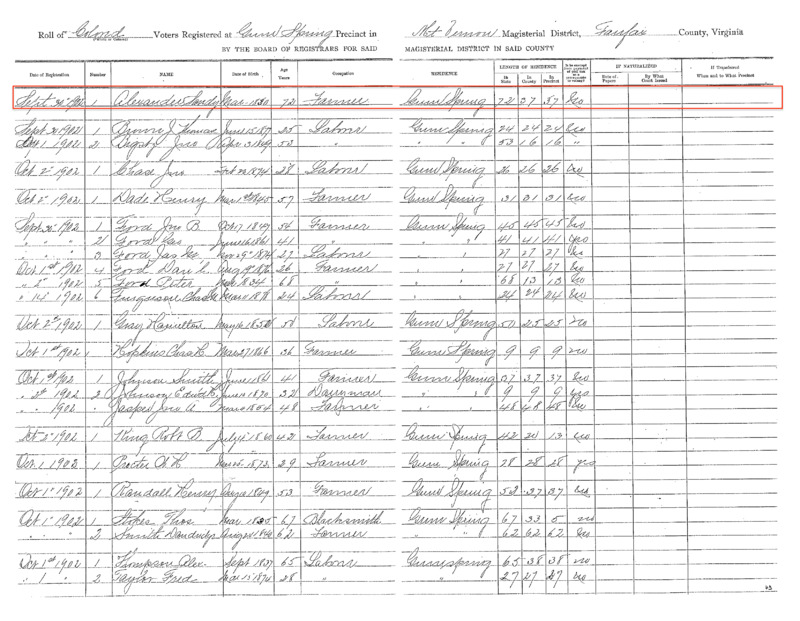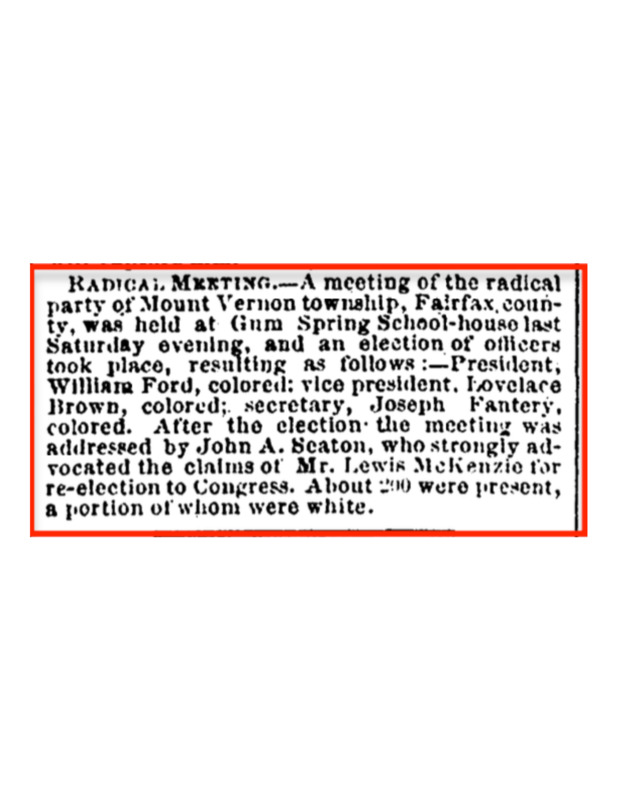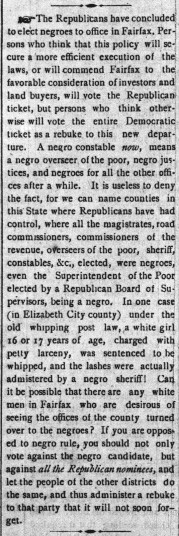Citizen Alexander and Future Research
It is important to note that there was significant resentment toward northern transplants and African American people between 1870-1920. The local newspaper The Fairfax Herald, consistently reported negative stories about Blacks and the Republican party who it claimed set Black members of the area against their white neighbors in order to promote their personal political and economic interests. Despite these tensions the Black population increased thirteen percent between 1860-1870 and equaled 5,264 in 1880 due to an additional twenty-three percent between 1870-1880.[1] During this period roughly one third of the total population in Fairfax County was African American and this likely was due to the increased ability to purchase new land and start businesses in an area that had cheap land prices and some whites who were willing to sell land to Black buyers.
Despite the resentment toward Black people in Fairfax County for their active participation in public life as documented by local newspapers many continued to exercise their newly acquired rights to assemble and to vote. Often these meetings of Black voters were called a “RADICAL MEETING” by the “Radical party of Mount Vernon township”[2] In 1870 they met at the “Gum Spring School-house” where they elected local leaders like William Ford, Lovelace Brown, Joseph Fantery. African American leader John A. Seaton addressed the meeting and encouraged continued support for the unionist and Republican candidate Lewis McKenzie for reelection to Congress but was defeated by Democratic party candidate Elliott M. Braxton.[3] The Washington Evening Star claimed “[a]bout 200 were present, a portion of whom were white.”[4] Seaton was an African American leader who enlisted in the Quartermaster’s Department in Alexandria, and then he enlisted in the colored Union troops during the Civil War. Following the war Seaton later held positions in the U.S. Department of Treasury and then another position for the U.S. Capitol police. In 1871 Seaton was appointed Alderman for the fourth ward in Alexandria City Council. Seaton, a Republican was renowned for his leadership and remained politically active in the period even after he took a job in New York for the Equitable Life Assurance Company where he earned a considerable annual salary of $2,200.[5] It is unclear if Alexander was an active leader of the Republican party in Gum Springs but he does show up in the “Colored Voters Registered at Gum Springs” at the Mt. Vernon district of Fairfax County in 1902.[6]
The local newspapers reported the resentment and animosity of local whites in several stories. The Fairfax News reported in 1873 that although election day was “quiet and orderly” a few days later on Saturday at a barbeque designed as an “attempt to harmonize the races” in Fairfax led to a fight in which “[s]ome colored blood was made to flow.” The article reports that various types of rocks were used in the fight.[7] Some articles reported their resentment toward anyone who claimed that the two races could live as social and political equals. The biggest offense seemed to be when an African American was nominated to serve as a political leader. In 1889 the Fairfax Herald reported to their readers that a Black man was nominated to serve as a Constable and whould have authority to present justice to Whites including using the “whipping post.” They flamed fears of a case in “Elizabeth City county” a Republican Black sheriff whipped “a white girl 16 or 17 years of age, charged with petty larceny” and the writers encourage all who were “opposed to negro rule” to vote “against all the Republican nominees.”[8] These few examples show only a fraction of the examples of the highly charged environment in Fairfax County’s post war political environment.
In the end there are many more avenues of research to explore. There are significant gaps in our understanding about the elections that occurred between 1867-1920. The 1867 election alone deserves significant investigation as does the notion of a “radical” political party that had a significant base in Gum Springs. We intend to continue exploring this topic beyond the participation of individuals like Sandy Alexander but we are fascinated by the choices people like Alexander made to contribute to the American experiment in Fairfax County.
[1] Nan Netherton et. all, Fairfax County, Virginia: A History (Fairfax, Va: Fairfax County Board of Supervisors, 1978), 445-447.
[2] “Alexandria,” Evening Star (Washington (DC), District of Columbia), August 30, 1870: 4. Readex: America's Historical Newspapers.
[3] "The Late Lewis McKenzie". Alexandria Gazette. 29 June 1895, image 2.
[4] “Alexandria,” Evening Star (Washington (DC), District of Columbia), August 30, 1870: 4. Readex: America's Historical Newspapers.
[5] Char McCargo Bah, “Alexandria’s John A. Seaton — ‘A Giant of a Man,’” The Connection to your community, October 1, 2018, http://www.connectionnewspapers.com/news/2018/oct/01/alexandrias-john-seaton-giant-man/.
[6] Fairfax County, “Roll of Colored Voters Registered at Gum Springs Precinct in Mt. Vernon Magisterial District, Fairfax County, Virginia,” 1902, Fairfax County Circuit Court, Historic Records Center, Fairfax, Virginia.
[7] Fairfax News, November 7, 1873; also see Nan Netherton et. all, Fairfax County, Virginia: A History (Fairfax, Va: Fairfax County Board of Supervisors, 1978), 453.
[8] Fairfax Herald, 17 May 1889; Nan Netherton et. all, Fairfax County, Virginia: A History (Fairfax, Va: Fairfax County Board of Supervisors, 1978), 446.
George D. Oberle III


